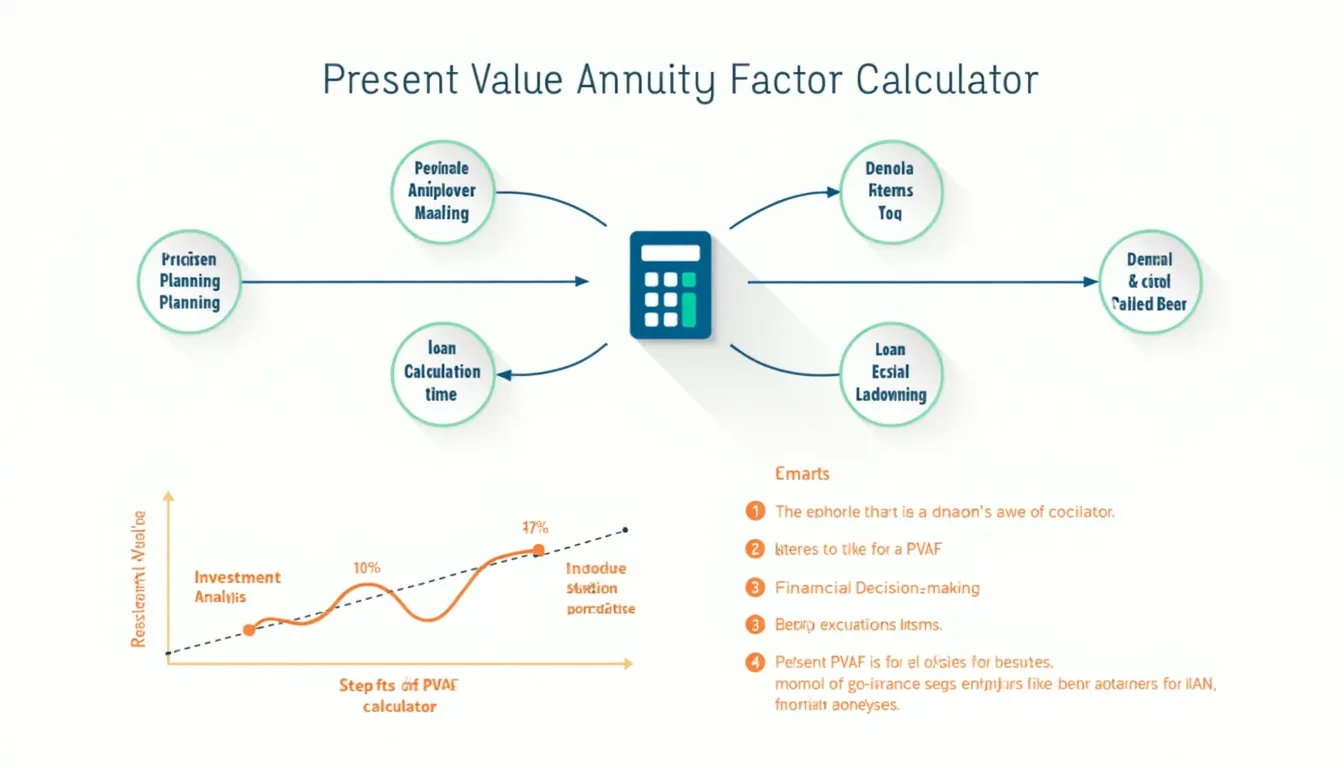Present Value Annuity Factor Calculator
Is this tool helpful?
How to use the tool
- Step 1 – Enter rate % per period. For instance, type 3.2 for a semi-annual bond or 0.7 for a monthly loan.
- Step 2 – Enter total periods. Examples: 18 semi-annual periods (9 years) or 60 monthly periods (5 years).
- Step 3 – Click “Calculate”. The tool returns the PVAF to four decimals.
- Step 4 – Find present value. Multiply PVAF by the recurring payment.
Underlying formula
$$PVAF = rac{1 – (1 + r)^{-n}}{r}$$
Example A
- Input: r = 3.2 %, n = 18.
- $$(1+0.032)^{-18}=0.5670$$
- $$PVAF= rac{1-0.5670}{0.032}=13.5297$$
- If each payment equals $900, present value = $900 × 13.5297 = $12 176.73.
Example B
- Input: r = 0.7 %, n = 60.
- $$(1+0.007)^{-60}=0.6580$$
- $$PVAF= rac{1-0.6580}{0.007}=48.8780$$
- A $400 payment stream is worth $19 551.20 today.
Quick-Facts
- Rate input range: 0.01 %-20 %; 30-year Treasury rates averaged 3.6 % in 2023 (U.S. Treasury, 2023).
- Periods accepted: 1-480, covering up to 40 years of monthly cash flows (FHFA Mortgage Terms, 2022).
- Formula matches CFA Institute Level I curriculum (CFA Institute, 2022).
- Common uses: retirement funding, bond pricing, loan amortization (Investopedia, https://www.investopedia.com/terms/p/present-value-annuity-factor.asp).
FAQ
What is the Present Value Annuity Factor?
PVAF is the multiplier that converts a series of equal, time-spaced payments into their lump-sum value today by discounting each payment at a constant rate (Investopedia, URL).
Why does a higher discount rate lower PVAF?
A higher rate increases the discount applied to each future payment, shrinking their present worth and therefore the PVAF (Brealey & Myers, 2020).
How do I convert an annual rate to a monthly rate?
Divide the nominal annual percentage rate by 12; e.g., 6 % ÷ 12 = 0.5 % per month (Federal Reserve Board, 2023).
Can I use the calculator for uneven payments?
No. PVAF assumes equal, periodic payments. Irregular cash flows require net-present-value analysis with individual discounting (CFA Institute, 2022).
What is the maximum number of periods I should enter?
Financial models rarely exceed 480 monthly periods (40 years) because cash-flow forecasts lose reliability beyond that horizon (FHFA Mortgage Terms, 2022).
How accurate is the tool?
It uses double-precision JavaScript math, giving at least 14 significant digits—well within professional valuation tolerance (ECMA-262, 2023).
Is PVAF useful for bond pricing?
Yes. “Discounting future cash flows is the backbone of bond valuation” (FINRA, 2023). Multiply each bond coupon by PVAF, then add the discounted principal.
How can sensitivity analysis improve my decision?
Run several rate or period scenarios; a one-point rate shift can alter a 30-year annuity’s present value by 12 % (Damodaran, 2022), clarifying risk.
Important Disclaimer
The calculations, results, and content provided by our tools are not guaranteed to be accurate, complete, or reliable. Users are responsible for verifying and interpreting the results. Our content and tools may contain errors, biases, or inconsistencies. Do not enter personal data, sensitive information, or personally identifiable information in our web forms or tools. Such data entry violates our terms of service and may result in unauthorized disclosure to third parties. We reserve the right to save inputs and outputs from our tools for the purposes of error debugging, bias identification, and performance improvement. External companies providing AI models used in our tools may also save and process data in accordance with their own policies. By using our tools, you consent to this data collection and processing. We reserve the right to limit the usage of our tools based on current usability factors.







